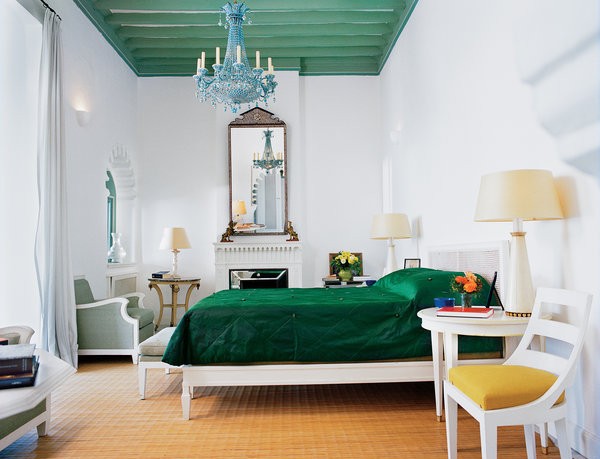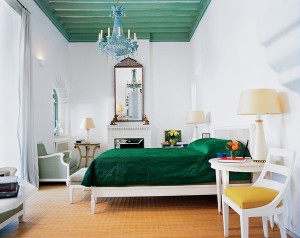By Marian McEvoy
The iconic fashion designer’s last residence, Villa Mabrouka, shows just how sophisticated ‘plain’ decorating can be — and how radical chintz can seem.
It’s the antithesis of his other homes. Villa Mabrouka in Tangier, Morocco, which the iconic fashion designer Yves Saint Laurent shared with his partner, Pierre Bergé, is the visual incarnation of a breath of fresh air. No collections of priceless paintings, museum-class Asian antiquities, Renaissance bronzes or walls clad in hand-carved wood paneling here. For almost a decade, until Saint Laurent’s death at 71 in 2008, his preference for artfully layered spaces heaped with beautiful rarities gave way to rooms of spare sophistication. The Villa Mabrouka (mabrouka is “luck” in Arabic) is by far his most surprising refuge and an object lesson in the power of paring back.
But first, the others: There was the two-bedroom apartment furnished with fine, early American furniture and oil paintings of American Indians in Manhattan’s Pierre hotel, and the 19th-century neo-Gothic Château Gabriel near Deauville, France. There was a sumptuous ground-floor apartment filled with French Art Deco furniture, antiquities and paintings by Picasso, Goya, Matisse and Ingres on the Rue de Babylone in Paris, and an exotic 1920s compound decorated with French colonial-era furniture and handcrafted Moroccan details, once owned by the painter Jacques Majorelle, in Marrakesh. Compared with Saint Laurent’s other residences, the rarely photographed or seen Villa Mabrouka is not only plain but cheery. His lifelong addictions, bouts with depression and nervous breakdowns have been recounted in numerous books, documentaries and, more recently, two feature films, but you’d be hard pressed to find anything sad or brooding here.
Life at Mabrouka was quiet and private. Saint Laurent read, listened to opera and the birds, and watched movies and fishing boats. He went on walks and shared simple meals with close friends, including his muses Betty Catroux and Loulou de la Falaise, the interior designer Alberto Pinto and the garden designer Madison Cox. The glamorous dinners and parties he ringmastered at his other houses were long over by the time he and Bergé moved in for the summer in 1999.
The villa is situated on a cliff five minutes uphill from downtown Tangier, overlooking the Strait of Gibraltar and the southern coast of Spain. Built in the 1960s, it incorporates Modernist and traditional Moroccan features including large, metal-framed floor-to-ceiling windows, whitewashed stucco walls, giant crenellated horseshoe arches and checkerboard-marble floors. One enters the walled compound through a circular courtyard shaded by a huge, drooping rubber tree and a phalanx of chest-high ferns. Sloping gardens spill over terraces laced with wide stone paths and steps that lead down to a biomorphic swimming pool carved into a hill of rock. Cox was responsible for planting palms, Italian lemon trees, climbing vines, iceberg roses, bougainvillea and hydrangea hedges, and installing a large dovecote. The expat American architect Stuart Church designed a pink stucco pavilion with a fireplace and windows looking onto the strait.
But it’s not Mabrouka’s scenery or the “Moroccan Moderne” architecture that stirs the heart; it’s the décor. Most of all, it’s the bold use of chintz. Invented centuries ago in Calicut, India, the glazed cotton fabric printed with colorful patterns depicting flowers, birds, trees, fruits and butterflies became wildly popular during the 17th and 18th centuries. Long considered a staple in the houses of European aristocracy, chintz was elevated in the 20th century by influential interior designers including Colefax and Fowler, Elsie de Wolfe and Rose Cumming. During the last half century, international decorators with a penchant for the pretty, traditional, European “country-house” style used miles of the stuff, often in matching patterns, for curtains, bed covers, wall coverings and upholstery in unabashedly feminine rooms frequently accompanied by needlepoint pillows, porcelain knickknacks and layers of ruffles. Given its association with décor overkill — and the growing love of anything hard-edged and midcentury-modern — chintz’s appeal faded. It took Saint Laurent and his decorator, Jacques Grange — who used it brazenly and sparingly in Villa Mabrouka’s big, tall, whitewashed rooms — to banish the folderol and make clichéd chintz look fresh again.
Grange, whose clients include Francis Ford Coppola, Valentino, François Pinault and the Mark hotel in New York, worked with Saint Laurent and Bergé for more than 30 years decorating most of their residences. He told me that collaborating with Saint Laurent at the Villa Mabrouka was a revelation: “For the first time in his life, Yves wanted a restful, open, happy environment — not a treasure palace,” he said. For the homes in Normandy, Paris and Marrakesh, Grange and Saint Laurent would often start by devising a scenario, or “storyline,” based on references to a person, painting or novel. The décor at Saint Laurent’s Château Gabriel was based on characters in Marcel Proust’s “In Search of Lost Time.” The style of the Rue de Babylone apartment spoke to the influence of two friends, Marie-Laure and Charles de Noailles — among the most important patrons of the arts in the 20th century. For Mabrouka, Saint Laurent conjured a Tangier house where an imaginary English couple might have lived in the 1950s. “When he suggested using chintz, I was astonished,” Grange said. “It was a totally new reference — one doesn’t automatically connect Saint Laurent’s taste in interior design with big, whimsical, turquoise and yellow floral prints.”
Contrary to what many people think, not all couturiers are gifted, or even competent, designers of rooms. (Coco Chanel, Hubert de Givenchy and Karl Lagerfeld are notable exceptions.) Saint Laurent’s personal decoration was as finely tuned and willful as his fashion collections. He was also one of the most avid collectors of fine art, objets and furniture of our time. He insisted on quality materials and workmanship, and he could afford them. Most crucially, he was a stubborn, driven rebel with a pitch-perfect take on glamour and fantasy. His rooms are impossible to copy.
Today, the Villa Mabrouka doesn’t look exactly like the photographs on these pages. All of the big upholstered sofas and armchairs remain in place, but many of the other furnishings and objects — the giant bronze Claude Lalanne water-lily mirrors and the library, for instance — have found a new home in Bergé’s current Tangier house nearby, the Villa Léon l’Africain. But Mabrouka’s bedrooms are untouched; even the padded basket-bed that belonged to the last of the fabled couturier’s four French bulldogs (all of them named Moujik) remains nestled in a corner.
The house has been on and off the market for a couple of years now, at prices in the $10 million range. But until some lucky soul snaps it up and transforms the House of Luck, it will retain the atmosphere that made it Yves Saint Laurent’s last, and most stylishly restful, stand.








